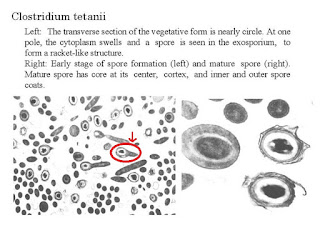 |
| patient with tetanus |
Tetanus is a disease of the nervous system that is caused by tetanospasmin neurotoxin produced by Clostridium tetani, which is characterized by persistent tonic spasme accompanied by a clear and hard attack. Clostridium tetani enter the human body through wounds usually in the form of spores. Disease appears when the spores grow into vegetative forms produce tetanospasmin at low oxygen pressure conditions, or tissue necrosis oxygen reduction potential.
Tetanus varied clinical manifestations of localized muscle stiffness, trismus until stiff and severe. Upheld diagnosis based on clinical findings and immunization history. Affairs on codes of conduct covering general, neutralizing toxins, bacteria elimination, supportive therapy and consultation when necessary. The severity and prognosis of tetanus can be seen from the degree of tetanus.
DEFINITIONS
Words taken from the Greek namely, from teinein which means tight. Tetanus is a disease of the nervous system that is caused by tetanospasmin neurotoxin produced by Clostridium tetani, characterized by persistent tonic spasme accompanied by a clear and hard attack. Spasme almost always occur on the neck and jaw muscles, causing the closure of the jaw (trismus, lockjaw), and involves the muscles of the torso above extremity muscles.
ETIOLOGY
Tetanus is caused by the bacteria Clostridium tetani, which is a gram-positive bacterium sticks measuring 0.5 μm - 1.7 μm x 2.1 μm - 18.1 μm and obligat anaerobic nature. These microorganisms produce spores at one end, and colorless spores oval to create the impression drummer (drum stick) or a tennis racket (racquet squash). These microorganisms can be found in two forms in the form of spores (dormant) and the vegetative form (active) that can reproduce themselves. Clostridium tetani spores are extremely resistant to chemical disinfectants, heating and drying.
DEFINITIONS
Words taken from the Greek namely, from teinein which means tight. Tetanus is a disease of the nervous system that is caused by tetanospasmin neurotoxin produced by Clostridium tetani, characterized by persistent tonic spasme accompanied by a clear and hard attack. Spasme almost always occur on the neck and jaw muscles, causing the closure of the jaw (trismus, lockjaw), and involves the muscles of the torso above extremity muscles.
ETIOLOGY
Tetanus is caused by the bacteria Clostridium tetani, which is a gram-positive bacterium sticks measuring 0.5 μm - 1.7 μm x 2.1 μm - 18.1 μm and obligat anaerobic nature. These microorganisms produce spores at one end, and colorless spores oval to create the impression drummer (drum stick) or a tennis racket (racquet squash). These microorganisms can be found in two forms in the form of spores (dormant) and the vegetative form (active) that can reproduce themselves. Clostridium tetani spores are extremely resistant to chemical disinfectants, heating and drying.
 |
| Clostridium Tetani Bactery |
Spores can only die with the autoclave at a pressure of 1 atm and 120 º C for 15 minutes. Clostridium tetani are found in the soil and 10% - 40% of dirt is very fond of animals and humid environments. These germs can also be found on dry land, dust, dirt horse, cow, pig, sheep, goat, dog, rat, chicken and human. Germs usually directly in to network hosts (humans) through traumatic injury, tissue necrosis, and less vascularisation network. At 15% - 25% of tetanus cases, no history of wound recovered.
Clinical symptoms that occur in tetanus toxin derived from the effect produced by These germs when transformed into endospora. Active bacteria produce two types of exotoxin, that tetanolisin and tetanospasmin. Tetanolisin locally capable of surviving mutilate network that surrounds the source of infection and optimize konndisi that allows multiplication of bacteria. Tetanospasmin is a neurotoxin that contribute to the onset of the clinical syndrome tetanus.
Tetanospasmin produced in infected cells under the control of spasmin. Tetanospasmin is a single polypeptide chain. By autolysis, single chain toxin is released and cleaves to form a heterodimer consisting of a heavy chain (100kDa) which mediate pengikatannya with nerve cell receptors and entry into the cell while the light chain (50kDa) have a role to block the release of neurotransmitters.
Resources:
1. Picture: http://immunizebc.ca/diseases-vaccinations/tetanus
2. Picture: http://www.naro.affrc.go.jp/english/niah/em/bacteria/042954.html
Related Articles
1. Pathophysiology of Tetanus
2. Clinical Manifestations of Tetanus
3. Diagnosis and Differential Diagnosis of Tetanus
4. Medical Treatment and Therapy of Tetanus
Related Articles
1. Pathophysiology of Tetanus
2. Clinical Manifestations of Tetanus
3. Diagnosis and Differential Diagnosis of Tetanus
4. Medical Treatment and Therapy of Tetanus